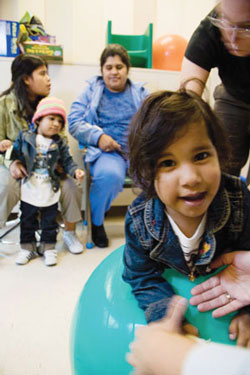January 22, 2008 - By Tracie White

Fiorella (left, rear) and Yurelia Rocha-Arias (right) play at their occupational therapy session while their mother, Maria Arias, sits in a chair in the rear.
Toddling across a room to reach a dollhouse is pretty normal stuff for most 2-year-olds. But for Fiorella and Yurelia Rocha-Arias, the formerly conjoined twins from San Jose, Costa Rica, the ability to make a mad dash to a pink dollhouse and play happily side-by-side is a big deal. A very big deal.
Born joined at the heart and chest, seemingly trapped forever face-to-face, the twins underwent an operation that separated them two months ago by surgeons at Lucile Packard Children's Hospital, and that has opened up a new world.
Instead of shuffling in a complicated four-footed side-step pattern across the room, the two are learning how to walk forward separately, each on their own.
They're learning how to adjust to a whole new center of gravity, literally.
'Every time I look at them, I just can't believe that they're separated,' said their mother, Maria Arias, speaking through an interpreter at a table in the therapy playroom at Packard Children's while watching her children's occupational therapy session. 'Ever since they were born it was very difficult for me. Only now am I beginning to relax.'
On the other hand, since their separation and return to good health, the twins are also starting to wear her out. The twins have suddenly been transformed from just one slow-moving body into two fast ones to chase around. So their mother has brought her 13-year-old daughter Cinthia - one of nine other siblings - from the family's home in Costa Rica to help. Maria is a domestic worker in Costa Rica and her husband José Luis Rocha is currently home with the other kids. The twins are scheduled to return home sometime later this week.
'They are doing really, really well,' said occupational therapist Sandra Rizzuto while managing the controlled chaos in the small room. With the help of Cinthia, she's got the 2-year-olds chasing plastic butterflies with nets, rolling balls around the room, pushing pink strollers in circles. They speak a little English, and a little Spanish, mostly 'mommy,' 'daddy,' 'baby,' and 'Sandra.'
In between feeding lessons and walking lessons, the play never stops. They squeal with delight. Laugh out loud. Scream with frustration. They snatch dolls from each other, hug, twirl, trip, crash.
In typical 2-year-old fashion, they're learning fast.
'They do like to play,' said Rizzuto, helping Fiorella feed herself spoonfuls of rice. Apparently Yurelia was doing most of the eating for the twins when they were still attached. Since they shared the same blood supply, it didn't matter that Fiorella didn't eat much. Now that she's forced to live off her own food intake, Rizzuto's been encouraging her to eat more. It's a messy job, but somebody's got to do it.
'It's pretty cool working with kids,' said Rizzuto, who has worked with the twins since four days after the surgery on Nov. 12. 'They can feel terrible and still want to play. Even in the ICU, even when they were critically ill in the hospital beds they were coloring with markers.'
When their mother first found out the twins were conjoined, she was just a little more than three months pregnant.
'It was a shock,' Arias said. 'When the doctor told me I became depressed. I never got used to it. After they were born, I didn't know how to hold them. I couldn't nurse them. It was too uncomfortable.'
From the beginning she wanted to have the operation to separate them.
'I always wanted to take the risk,' she said. 'I put it in God's hands. It was very scary. God made it happen using the doctors.'
The twins are dressed in matching purple velvet dresses, chosen on their own, with matching pink tights and black Mary Jane shoes. Whatever one has, the other has to have too.
'We're trying to teach them to be more independent,' Rizzuto said. Still, they don't like to be separated. They sleep together, eat together, play together and fight together. They're still siblings, after all.
Since being separated, their bodies have healed remarkably well. They'll both carry the scars of the surgery, though. And for now, their heads still tilt to one side, their smiles slightly crooked. For the first two years of their lives they had to tilt their heads to the side just to smile at the world.
They used to try to play when they were together as one, but it was tough going, their mother said. They'd pull in opposite directions, then they'd fight and trip and fall.
They still have the tendency to shuffle sideways instead of walking forward. But with the help of occupational therapy and physical therapist Richard Gee, they've made tremendous progress at moving forward.
Neither therapist had ever worked with conjoined twins before, because there are only about five such operations done each year in the United States. But working with 2-year-olds makes the job easier, Rizzuto said. Play is therapy after all, and that's all the twins want to do.
'As long as they're happy, we're happy,' she said, watching the twins apply kid lipstick somewhere near their lips, then lick it all off. 'They're characters, these two.'
They'll definitely be missed when they head back home later this month, Rizzuto said, waving goodbye to the two as they walk off straightforward to the door.
'Bye!' said Fiorella, proudly pushing her pink stroller out the door.
About Stanford Medicine
Stanford Medicine is an integrated academic health system comprising the Stanford School of Medicine and adult and pediatric health care delivery systems. Together, they harness the full potential of biomedicine through collaborative research, education and clinical care for patients. For more information, please visit med.stanford.edu.